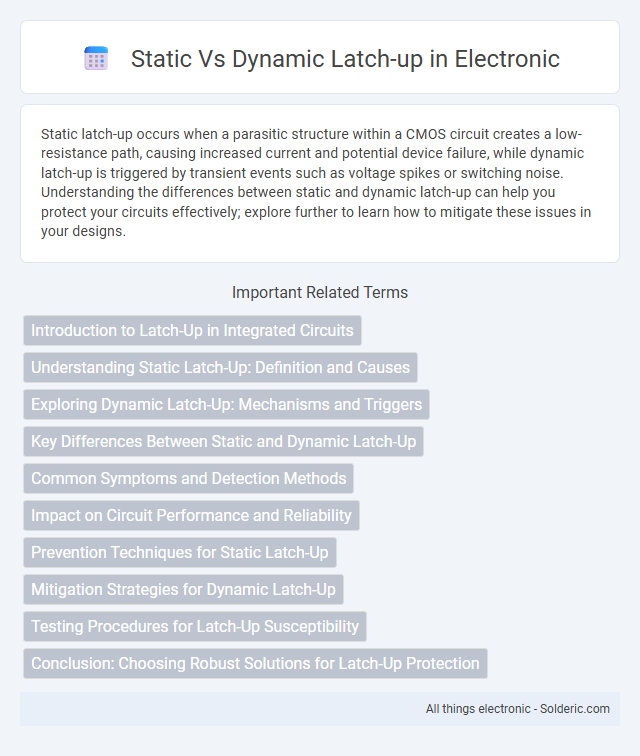Static latch-up occurs when a parasitic structure within a CMOS circuit creates a low-resistance path, causing increased current and potential device failure, while dynamic latch-up is triggered by transient events such as voltage spikes or switching noise. Understanding the differences between static and dynamic latch-up can help you protect your circuits effectively; explore further to learn how to mitigate these issues in your designs.
Comparison Table
| Feature | Static Latch-up | Dynamic Latch-up |
|---|---|---|
| Definition | Latch-up occurring under steady-state conditions. | Latch-up triggered by transient events or dynamic changes. |
| Cause | Continuous supply voltage enabling parasitic thyristor conduction. | Voltage spikes, transient currents, or switching noise. |
| Trigger Source | DC supply or static bias conditions. | Transient disturbances like ESD, surges, or fast transient signals. |
| Duration | Stable, often persistent latch-up until power reset. | Usually brief but can cause permanent damage. |
| Typical Occurrence | When device operates at nominal voltage with poor layout or doping. | During switching events or external transient stress. |
| Prevention | Optimized layout, guard rings, proper doping profiles. | Transient protection, filtering, and fast response circuits. |
| Impact | High current shorts affecting circuit functionality. | Momentary or permanent device failure from transient stresses. |
Introduction to Latch-Up in Integrated Circuits
Latch-up in integrated circuits occurs when parasitic structures create a low-impedance path, causing excessive current flow that can damage the device. Static latch-up involves a fixed parasitic thyristor triggering under certain voltage conditions, whereas dynamic latch-up is induced by transient disturbances like voltage spikes or high-frequency signals. Understanding these mechanisms helps you design more robust ICs by implementing preventive measures such as guard rings and proper substrate biasing.
Understanding Static Latch-Up: Definition and Causes
Static latch-up is a parasitic thyristor structure within CMOS circuits that triggers a low-impedance path between the power supply and ground, causing high current flow and potential device failure. It is primarily induced by localized high voltage or current spikes, improper substrate biasing, or manufacturing defects that allow unintended transistor triggering. Identifying these causes is crucial for improving latch-up immunity through circuit design optimization and process control.
Exploring Dynamic Latch-Up: Mechanisms and Triggers
Dynamic latch-up occurs when transient disturbances like voltage spikes or rapid switching induce a parasitic thyristor structure to enter a low-impedance state, causing excessive current flow that can permanently damage CMOS circuits. The primary trigger involves rapid changes in substrate or well biasing, which activate minority carrier injection in the silicon, fostering regenerative feedback within the parasitic bipolar transistors. Understanding these mechanisms is crucial for improving IC design robustness against power supply variations and electromagnetic interference.
Key Differences Between Static and Dynamic Latch-Up
Static latch-up occurs when a parasitic thyristor inside an integrated circuit is triggered by a low-voltage condition, causing a permanent short circuit until power is removed. Dynamic latch-up, on the other hand, is induced by transient events like voltage spikes or fast switching, leading to temporary conduction that may self-recover without power cycling. Understanding these key differences helps you design robust circuits that mitigate latch-up risks tailored to specific operating conditions.
Common Symptoms and Detection Methods
Static latch-up often manifests as a persistent high current leakage and device failure under steady-state conditions, typically detected using DC current monitoring and thermal imaging to identify hotspots. Dynamic latch-up presents as transient disturbances or noise in signal integrity during switching events, commonly detected through oscilloscopes and transient voltage/current waveform analysis. Both types require precise fault isolation techniques and can be diagnosed by correlating abnormal electrical behavior with operational conditions.
Impact on Circuit Performance and Reliability
Static latch-up causes prolonged high current conditions, leading to significant performance degradation and potential permanent damage to the circuit, severely impacting reliability. Dynamic latch-up results in transient disturbances that temporarily disrupt circuit operation but often allow recovery without lasting harm, posing a lesser threat to reliability. Understanding these impacts helps you design circuits with improved fault tolerance and operational stability.
Prevention Techniques for Static Latch-Up
Prevention techniques for static latch-up primarily involve designing CMOS circuits with guard rings and well taps to isolate parasitic structures and reduce latch-up susceptibility. Using lightly doped substrates and optimizing layout to increase the distance between p-well and n-well regions minimize the triggering of parasitic thyristors. Implementing low-resistance contacts and incorporating substrate biasing further enhance immunity by maintaining stable potential differences and preventing unintended current paths.
Mitigation Strategies for Dynamic Latch-Up
Mitigation strategies for dynamic latch-up primarily involve optimizing circuit design to reduce susceptibility to transient currents and voltage spikes that trigger parasitic thyristor action. Techniques such as implementing guard rings, increasing the substrate doping concentration, and using silicon-on-insulator (SOI) technology effectively isolate sensitive regions and suppress latch-up initiation. Careful layout design, including maintaining proper spacing between devices and enhancing well-tap efficiency, further minimizes the risk of dynamic latch-up in integrated circuits.
Testing Procedures for Latch-Up Susceptibility
Latch-up susceptibility testing involves applying specific voltage and current conditions to stimulate parasitic structures within CMOS devices, differentiating static latch-up by constant voltage stress and dynamic latch-up by transient switching activities. Evaluation methods include DC IV characterization for static latch-up and pulsed stress tests replicating operational switching for dynamic latch-up to identify latch-up threshold currents and triggering conditions. Compliance with JEDEC standards like JESD78 and JESD24-11 ensures standardized procedures for assessing both static and dynamic latch-up reliability in integrated circuits.
Conclusion: Choosing Robust Solutions for Latch-Up Protection
Static latch-up occurs when a parasitic thyristor within an integrated circuit is triggered and remains latched, causing a high current state. Dynamic latch-up involves transient triggering due to rapid changes in voltage or current, leading to momentary but potentially damaging effects. Selecting robust latch-up protection requires understanding the circuit's operating environment and implementing design techniques such as guard rings, substrate contacts, and controlled doping profiles to ensure both static and dynamic latch-up immunity.
Static vs Dynamic latch-up Infographic

 solderic.com
solderic.com